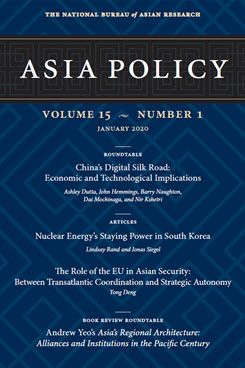Introduction to China’s Digital Silk Road
Economic and Technological Implications
Each of the authors in this roundtable examines a different aspect of China’s ambitions and initiatives in the Digital Silk Road, including projects and investments in artificial intelligence, smart city development and deployment, the Internet of Things, 5G technologies, fiber-optic cable construction, financial technologies, social networking, and blockchain.
Over the last few years, many researchers have analyzed China’s Belt and Road Initiative, yet very few have studied a growing and critical component of that initiative—the Digital Silk Road (DSR). Since the DSR could have enormous economic, technological, social, political, and security implications for the United States and other countries around the world, the National Bureau of Asian Research sought to address the current gap in research on this topic. In September 2019 we hosted a workshop that brought together experts to examine China’s DSR activities in Southeast Asia—a region that has been an intense focus of the DSR—and the implications for the United States and Japan in particular. This roundtable in Asia Policy builds on the presentations and discussions at that workshop.
As the four essays in this roundtable demonstrate, the DSR includes a broad set of Chinese public policies, information and communications technology (ICT) infrastructure development projects, and public- and private-sector investments. These efforts aim to strengthen China’s international leadership and capabilities in emerging technologies, which support and link to many of China’s other major goals in its grand strategy. Each of the authors in this roundtable examines a different aspect of China’s ambitions and initiatives in the DSR, including projects and investments in artificial intelligence (AI), smart city development and deployment, the Internet of Things, 5G technologies, fiber-optic cable construction, financial technologies (fintech), social networking, and blockchain.
In the first essay, John Hemmings argues that the DSR is a core piece of China’s attempt to restructure the global order through the Belt and Road Initiative, and that China is using new communications technologies, especially 5G, to build a global information highway with China at its center. He examines the strategic implications of the DSR initiative, concluding that “the marriage of ICT to infrastructure has perhaps been the winning formula for China, as it has allowed Beijing to promote its own standards, its own companies, and its own digital highway, granting it the benefits of new captive markets for Chinese tech firms, rich sources of data for analysis, and tools for leverage over foreign political and business elites.”
In the second essay, Barry Naughton examines China’s industrial policies that support the DSR, namely the prioritization of new technologies surrounding AI and 5G, the growing focus on private companies rather than state-owned enterprises, and regional plans to create urban clusters supported by digital “smart” technologies. He uses Alibaba’s City Brain program in Malaysia as a case study to demonstrate how these policies can come together in DSR initiatives in Southeast Asia. He points out that the success of Alibaba in Malaysia reflects market-based and technological forces, not only Chinese government initiatives. This implies that the magnitude of the challenge emerging from the DSR is much greater and more complex than if the outcome were due exclusively to top-down Chinese government policy. He concludes that policymakers and businesses in the United States, Japan, and other advanced economies must focus more attention on providing attractive alternatives to the Chinese model.
The third essay, by Dai Mochinaga, explores China’s ICT infrastructure development and cyber influence as part of the DSR and analyzes Japan’s response. China has recognized that being an ICT leader is key to achieving its goals. It seeks to lead not only on infrastructure development such as fiber-optic cable construction but also on standards setting and related legal frameworks. While China’s actions as part of the DSR are concerning to Japan, Tokyo has chosen not to confront the DSR or China directly. Instead, it has responded indirectly by both improving its own cybersecurity policies and promoting its free and open Indo-Pacific vision for the region.
Finally, Nir Kshetri assesses China’s success in the fintech sector and the attempts of Chinese companies to replicate that success in Southeast Asia as part of the DSR. The unmet financial needs of the large unbanked population in the region have provided new opportunities for Chinese companies to export their financial models and services. These companies have successfully adapted technologies developed in other industrial countries to meet local needs and conditions at home and abroad. But while they may be filling demand for financial services, these companies are also exposing their customers to risks. Many Chinese fintech platforms perform poorly in security and privacy, and Chinese companies may face pressure from the Chinese government to carry out censorship and surveillance in these new markets. Kshetri argues that the United States and its allies like Japan must make special efforts in Southeast Asia both to encourage countries to improve data privacy, cybersecurity, and surveillance regulations and to educate consumers and governments on risks. Closer collaboration with governments in the region will also be important for addressing these challenges.
The research on China’s DSR in these essays should concern business leaders and policymakers in the United States and other market democracies around the world, particularly those in Asia that are major technology players. Future U.S. economic strength and security depend on leading in technological innovation and ensuring that new technologies are utilized in ways that align with U.S. values such as freedom, privacy, and democracy. For this reason, the United States and other like-minded countries must improve their efforts to understand China’s actions as part of the DSR and develop strategies to counter China’s influence by offering competitive, attractive alternatives.
Ashley Dutta is Senior Director of the Center for Innovation, Trade, and Strategy at the National Bureau of Asian Research.
About Asia Policy
Asia Policy is a peer-reviewed scholarly journal presenting policy-relevant academic research on the Asia-Pacific that draws clear and concise conclusions useful to today’s policymakers. Asia Policy is published quarterly in January, April, July, and October and accepts submissions on a rolling basis. Learn more



